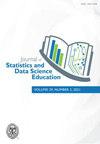学生能从错误代码中学到更多吗?在无错误与全错误的SAS®编程环境中探索学生的表现和满意度
IF 1.6
Q2 EDUCATION, SCIENTIFIC DISCIPLINES
Journal of Statistics and Data Science Education
Pub Date : 2021-09-02
DOI:10.1080/26939169.2021.1967229
引用次数: 1
摘要
摘要教学生统计编程语言,同时教他们如何调试错误代码是一项挑战。传统的编程课程侧重于课堂上的无错误学习,而学生的课外体验通常涉及完全错误的学习。虽然无错误教学由强调正确编码的重点讲座组成,但在此类讲座之后,错误教学将包括调试课程。我们旨在通过对18名研究生进行试点研究来探索这两种方法,这些研究生自愿参加了2018年9月至2018年11月每周举行的SAS编程研讨会。每个研讨会都有10分钟的无错误讲座、15分钟的编程作业、5分钟的休息、10分钟的错误完整讲座和15分钟的程序作业。我们考察了学生的表现和偏好。四名学生成功完成了两项作业,十名学生没有成功完成任何一项作业,一名学生只成功完成了无错误讲座后的第一项作业,三名学生只完成了错误完整讲座后的第二项作业。在回答的15名学生中,12名(80%)的学生更喜欢完全错误的学习,而不是无错误的学习。我们将在SAS入门课程中对全面错误学习进行更大规模的评估。本文的补充文件可在线获取。本文章由计算机程序翻译,如有差异,请以英文原文为准。
Do Students Learn More from Erroneous Code? Exploring Student Performance and Satisfaction in an Error-Free Versus an Error-full SAS® Programming Environment
Abstract Teaching students statistical programming languages while simultaneously teaching them how to debug erroneous code is challenging. The traditional programming course focuses on error-free learning in class while students’ experiences outside of class typically involve error-full learning. While error-free teaching consists of focused lectures emphasizing correct coding, error-full teaching would follow such lectures with debugging sessions. We aimed to explore these two approaches by conducting a pilot study of 18 graduate students who voluntarily attended a SAS programming seminar held weekly from September 2018 through November 2018. Each seminar had a 10-min error-free lecture, 15-min programming assignment, 5-min break, 10-min error-full lecture, and 15-min programming assignment. We examined student performance and preference. While four students successfully completed both assignments and ten students did not successfully complete either assignment, one student successfully completed only the first assignment that directly followed the error-free lecture and three students successfully completed only the second assignment that directly followed the error-full lecture. Of the 15 students who responded, twelve (80%) preferred error-full to error-free learning. We will evaluate error-full learning on a larger scale in an introductory SAS course. Supplemental files are available online for this article.
求助全文
通过发布文献求助,成功后即可免费获取论文全文。
去求助
来源期刊

Journal of Statistics and Data Science Education
EDUCATION, SCIENTIFIC DISCIPLINES-
CiteScore
3.90
自引率
35.30%
发文量
52
审稿时长
12 weeks
 求助内容:
求助内容: 应助结果提醒方式:
应助结果提醒方式:


